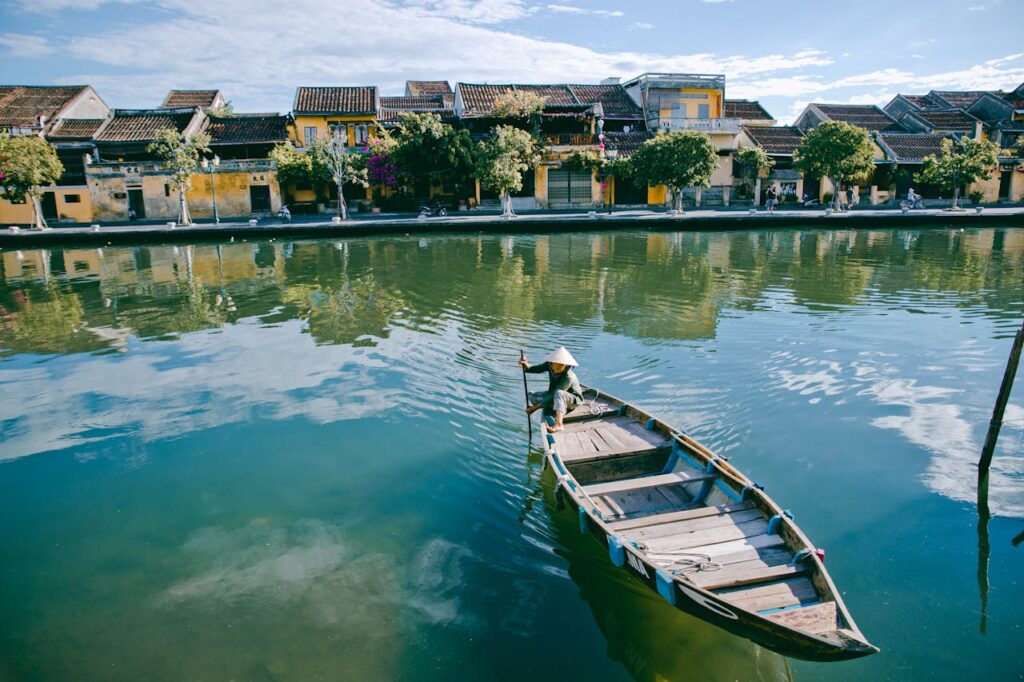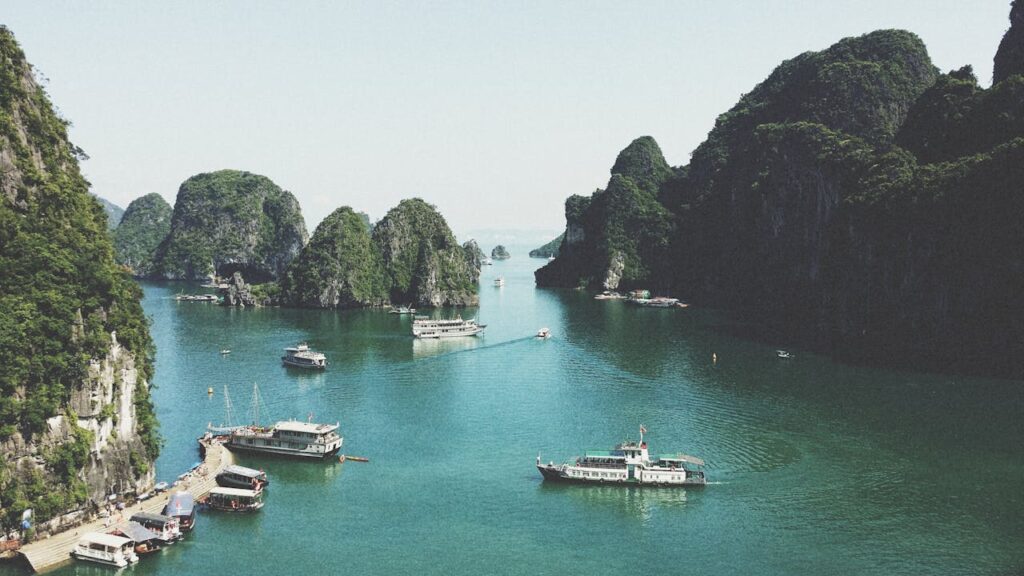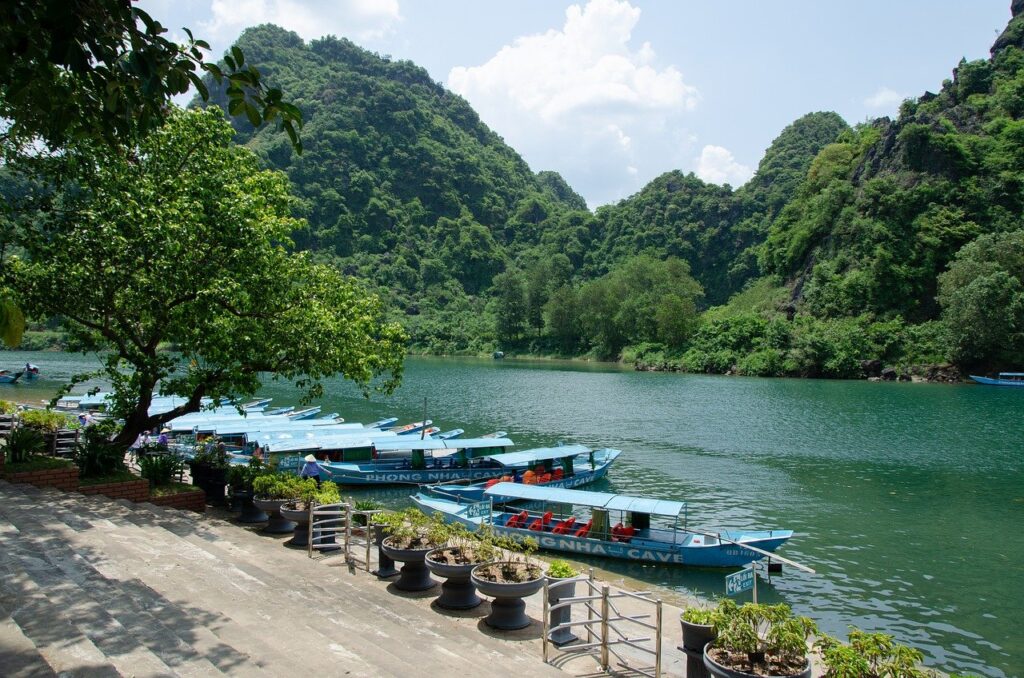Ho Chi Minh City, also known as Saigon, is Vietnam’s largest city and a vibrant metropolis known for its rich history, bustling markets, and dynamic energy. As a former capital of French Indochina, the city blends colonial architecture with modern skyscrapers, offering a unique cultural and historical experience. From war museums to lively street food scenes, Ho Chi Minh City is a hub of activity and exploration. Here are some of the best places to visit in Ho Chi Minh City, Vietnam:
Best Places to Visit
1. Notre-Dame Cathedral Basilica of Saigon
The Notre-Dame Cathedral Basilica of Saigon is an iconic landmark in the heart of Ho Chi Minh City. Built between 1863 and 1880, this stunning cathedral features French Gothic architecture and twin bell towers that stand over 58 meters tall. The cathedral is constructed entirely of materials imported from France, including red bricks from Marseille. It remains an active place of worship and a popular tourist attraction, offering a glimpse into the city’s colonial past.
- Key Attractions: French Gothic architecture, twin bell towers.
- Activities: Sightseeing, photography.
- Location: District 1, Ho Chi Minh City.
2. Ben Thanh Market
Ben Thanh Market is one of Ho Chi Minh City’s oldest and most famous markets, known for its vibrant atmosphere and wide range of goods. The market is a bustling hub where locals and tourists shop for everything from clothing and souvenirs to fresh produce and street food. It’s an excellent place to experience the local culture and taste traditional Vietnamese dishes like pho, banh mi, and fresh spring rolls. The market’s iconic clock tower is a recognizable symbol of the city.
- Key Attractions: Local products, street food, souvenirs.
- Activities: Shopping, dining, cultural exploration.
- Location: District 1, Ho Chi Minh City.
3. War Remnants Museum
The War Remnants Museum is a powerful and sobering museum that documents the effects of the Vietnam War on the country. The museum’s exhibits include photographs, artifacts, and military equipment, providing a comprehensive overview of the war’s impact on both soldiers and civilians. Highlights include the “Tiger Cages,” replicas of prison cells used to hold political prisoners, and a collection of aircraft and tanks. The museum offers an important historical perspective and is a must-visit for those interested in Vietnam’s recent history.
- Key Attractions: War artifacts, historical exhibits.
- Activities: Museum exploration, educational learning.
- Location: District 3, Ho Chi Minh City.
4. Cu Chi Tunnels
The Cu Chi Tunnels are an extensive network of underground tunnels used by the Viet Cong during the Vietnam War. Located about 70 kilometers northwest of the city, the tunnels served as hiding spots, supply routes, and living quarters for soldiers. Visitors can explore a section of the tunnels, learning about the harsh conditions and ingenious strategies employed by the Viet Cong. The site includes exhibits of booby traps, weapons, and other wartime relics, providing a fascinating insight into guerrilla warfare.
- Key Attractions: Underground tunnels, wartime relics.
- Activities: Tunnel exploration, historical learning.
- Location: Cu Chi District, Ho Chi Minh City.
5. Saigon Central Post Office
The Saigon Central Post Office is a stunning example of French colonial architecture, designed by Gustave Eiffel. Completed in 1891, the building features a grand facade, high arched ceilings, and beautiful tilework. The interior is equally impressive, with a large map of Vietnam, antique telephone boxes, and a portrait of Ho Chi Minh. The post office is still operational, and visitors can send postcards, purchase stamps, and admire the building’s historical and architectural significance.
- Key Attractions: French colonial architecture, historical artifacts.
- Activities: Sightseeing, mailing postcards.
- Location: District 1, Ho Chi Minh City.
6. Reunification Palace
The Reunification Palace, also known as the Independence Palace, is a historic building that played a key role in the end of the Vietnam War. The palace was the residence of the President of South Vietnam and served as the site of the official handover of power in 1975. Today, the palace is a museum, showcasing the original furnishings, war command rooms, and a basement with tunnels. The building’s unique 1960s architecture and historical significance make it a fascinating place to visit.
- Key Attractions: Historical rooms, war command center.
- Activities: Museum exploration, historical learning.
- Location: District 1, Ho Chi Minh City.
7. Saigon Opera House (Municipal Theatre)
The Saigon Opera House is a beautiful French colonial building located in the heart of the city. Completed in 1897, the opera house features an elegant facade with intricate carvings and a grand interior with a capacity of over 500 seats. The venue hosts a variety of performances, including opera, ballet, and traditional Vietnamese music. The Saigon Opera House is a cultural landmark and a great place to experience the city’s vibrant arts scene.
- Key Attractions: French colonial architecture, live performances.
- Activities: Attending performances, sightseeing.
- Location: District 1, Ho Chi Minh City.
Summary Table
| Place | Description | Key Attraction | Distance from City Center |
|---|---|---|---|
| Notre-Dame Cathedral Basilica of Saigon | Iconic French Gothic cathedral | Twin bell towers, stained glass windows | District 1, Ho Chi Minh City |
| Ben Thanh Market | Bustling market with local goods and street food | Souvenirs, traditional dishes | District 1, Ho Chi Minh City |
| War Remnants Museum | Museum documenting the Vietnam War | War artifacts, historical exhibits | District 3, Ho Chi Minh City |
| Cu Chi Tunnels | Network of underground tunnels used during the Vietnam War | Tunnel exploration, war relics | Cu Chi District, Ho Chi Minh City |
| Saigon Central Post Office | French colonial building with historical significance | Architectural design, Gustave Eiffel | District 1, Ho Chi Minh City |
| Reunification Palace | Historic palace associated with the end of the Vietnam War | War command center, presidential rooms | District 1, Ho Chi Minh City |
| Saigon Opera House | French colonial opera house with cultural performances | Live performances, cultural events | District 1, Ho Chi Minh City |
How to Reach Ho Chi Minh City
By Plane
Tan Son Nhat International Airport (SGN) is the main airport serving Ho Chi Minh City, offering both domestic and international flights. The airport is located about 6 kilometers from the city center. From the airport, travelers can take taxis, shuttle buses, or private transfers to their destinations.
By Train
Ho Chi Minh City is connected to other major cities in Vietnam by the North-South Railway, also known as the Reunification Express. The main train station, Saigon Railway Station, is located in District 3. The train journey offers scenic views of the Vietnamese countryside.
By Bus
Buses are a popular mode of transportation to and from Ho Chi Minh City. The city has several bus terminals, including Mien Dong and Mien Tay, which serve routes to various destinations in Vietnam. Buses are an affordable and convenient way to travel around the country.
By Car
Visitors can rent a car or hire a private driver to explore Ho Chi Minh City and its surrounding areas. The city’s road network is extensive, but traffic can be heavy, especially during peak hours.
Best Time to Visit Ho Chi Minh City
The best time to visit Ho Chi Minh City is during the dry season, from December to April, when the weather is warm and dry with little rainfall. This period is ideal for exploring the city’s outdoor attractions and historical sites. The wet season, from May to November, brings occasional heavy showers, but the city remains vibrant and active.
Travel Tips
- Local Cuisine: Ho Chi Minh City is a food lover’s paradise, offering a diverse range of Vietnamese dishes. Must-try dishes include pho (noodle soup), banh mi (Vietnamese sandwich), and goi cuon (spring rolls). The city’s street food scene is vibrant, with numerous vendors offering delicious and affordable options.
- Cultural Insights: The city has a rich cultural heritage, influenced by Vietnamese, Chinese, and French traditions. When visiting religious sites, dress modestly and remove your shoes before entering. Respect local customs and traditions, and be mindful of cultural etiquette.
- Safety Tips: Ho Chi Minh City is generally safe for tourists, but it’s important to take standard precautions. Keep personal belongings secure, especially in crowded areas and on public transportation. Be cautious when crossing the street, as traffic can be chaotic.
Itinerary Suggestions
One-Day Trip
- Morning: Start your day with a visit to the Notre-Dame Cathedral Basilica of Saigon and the Saigon Central Post Office. Afterward, explore the War Remnants Museum to learn about Vietnam’s history.
- Afternoon: Have lunch at a local restaurant, then visit the Reunification Palace to explore its historical rooms and exhibits. In the afternoon, head to Ben Thanh Market for shopping and street food.
- Evening: End your day with a visit to the Saigon Opera House, enjoying a cultural performance or simply admiring the building’s architecture. Have dinner at a nearby restaurant.
Weekend Getaway
- Day 1: Begin with visits to the Notre-Dame Cathedral, Saigon Central Post Office, and War Remnants Museum. In the afternoon, explore the Cu Chi Tunnels and learn about the history of the Vietnam War. In the evening, enjoy the vibrant atmosphere of Ben Thanh Market.
- Day 2: Start with a morning visit to the Reunification Palace and explore its historical significance. In the afternoon, relax at a local cafe or explore the city’s shopping districts. Conclude your trip with a dinner cruise along the Saigon River, enjoying the city lights and views.
Ho Chi Minh City’s dynamic energy, rich cultural heritage, and diverse attractions make it a captivating destination in Vietnam. Whether you’re exploring its historical sites, experiencing its vibrant markets, or enjoying its culinary delights, Ho Chi Minh City offers a rich and memorable experience for all visitors.





